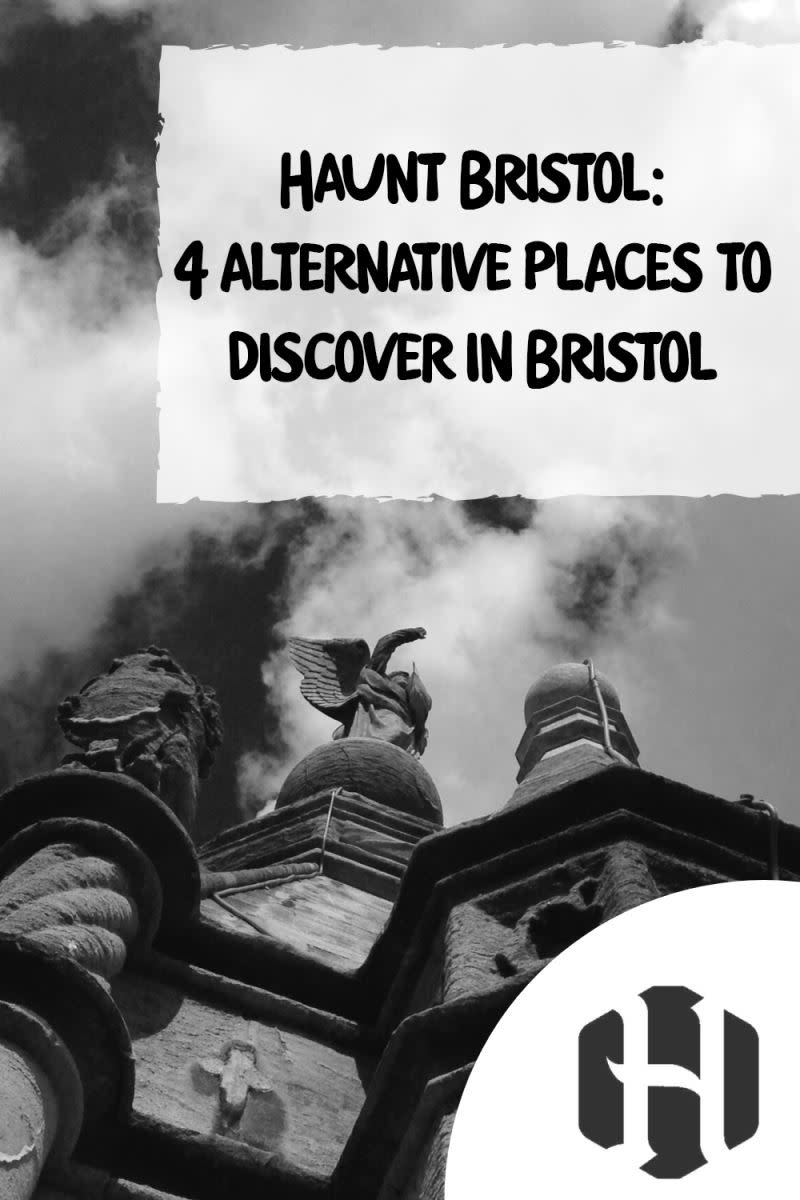Bristol is a city bustling with strange stories and mysterious tales – built on a history stemming back to Iron Age forts and Roman villas by the rivers Frome and Avon as early as the 11th century.
There’s even a story behind the name. ‘Bristol’ is thought to derive from the Old English ‘Brycgstow’, meaning ‘the place at the bridge’, and the city is still famed for its variety of bridges today. Many people know of The Clifton Suspension Bridge – famously based on the design ideas of Isambard Kingdom Brunel – yet there are also many more bridges you may not be aware of, with an impressive 45 walkable bridges currently covering the main waterways of the city (there’s even The Bristol Bridges Walk Challenge if you fancy taking them on!).
Bridges link up a city studded with heritage buildings, winding passageways and plenty of port history, with Bristol the starting site of many explorations of the New World from the 15th century onwards – and even the reported birthplace of Blackbeard! Tales of pirates and ghosts, hiding places, secret tunnels and the punishment of the gallows pole, abound. Perhaps it is little wonder that The Jenny Cooper crime series by M.R. Hall is based here!
‘Hidden Heritage’ might touch on subjects that are difficult, but important to talk about too. For example, Bristol Museum & Art Gallery provides a place to learn and reflect on Bristol’s former involvement in the Transatlantic Slave Trade, recognising the lives lost and moving forward with awareness. Considering life, death and trade over the years in the city is key to delving deeper into its history, with sites of cemeteries and executions, murders and mysteries - crucial to learning more about location.
Even in recent years, alternative events and happenings have continued to build in Bristol. This is the city that saw reports of ghostly sightings arise from the Bristol Old Vic Theatre (the longest continuosly running theatre in the country), the infamous 1990 Stone Roses gig at the evocatively-named Spike Island, the creation of impressive and unusual street art, the expansion of a unique underground music scene and much more. People come to visit from all over the world, inspired by the story of these spaces and places.
Here at Haunt Bristol, we feature some of the city’s alternative tourism offering…
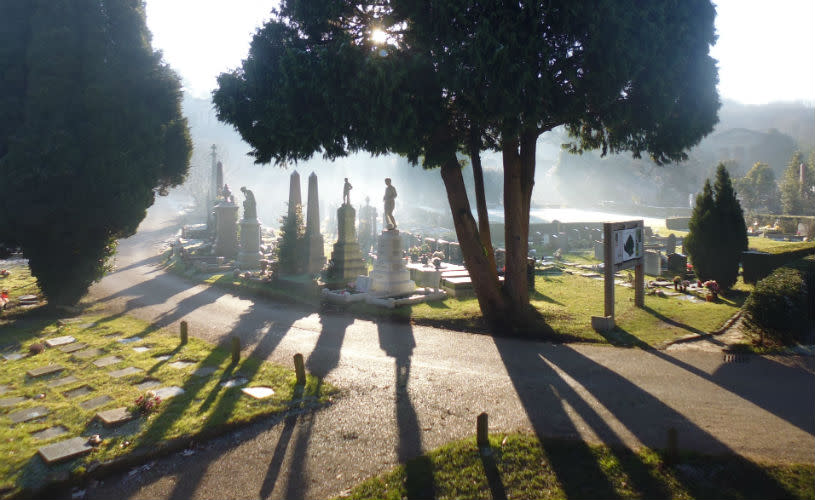
Image: Arnos Vale Cemetery
Arnos Vale Cemetery
Located just outside the city centre on the road from Bristol to Bath, Grade II* listed Arnos Vale Cemetery is a National Heritage Site and still a working cemetery - open since 1839 and remembering more than 300,000 people to date. Set within 45 acres of woodland, the cemetery was built in the style of a Greek Necropolis – imitating the elaborate tomb layouts and monuments of Ancient Greece – designed by Charles Underwood. It is a fascinating place to visit.
Often cited as a prime example of a ‘Victorian Garden’ cemetery, it contains a number of different plots and areas, each with their own distinct identity. For example, there is ‘Soldiers Corner’ where 239 casualties of WWI are buried, and Arnos Vale Cemetery marks the resting place of more than 530 WWI and WWII servicemen and women altogether. The cemetery was also designed to be a place for a range of faiths, with different spaces for different groups. To this day, the Mausoleum of Raja Ram Mohan Roy (often nicknamed the ‘Father of the Indian Renaissance’) is still a place of pilgrimage for many people, whilst his statue can be seen in the city itself on College Green.
A visit to Arnos Vale Cemetery can be a whole-day’s exploration, whether that is a self-guided walk on the trail or a guided tour, with the cemetery also putting on regular events and activities. Historically, people have even lived within the cemetery grounds, with cemetery staff occupying specially-built lodges – there are said to be tunnels underneath them, now home to roosting bats!
Intrigued? The gates are open to the public from 9am to 5pm every day, whilst the visitor centre is open from 10am to 4pm. Given the wide public interaction with the cemetery today – everything from ‘Morbid Curiosity Tours’ and Death Cafes to yoga and weddings – it is perhaps hard to believe it faced falling into disrepair in the 20th century. By the 1980s worries abounded that the site of Arnos Vale Cemetery was under threat from housing development, yet, significantly thanks to the hard work of the general public and campaigning groups, Bristol City Council went on to buy it. The cemetery is now run by Arnos Vale Cemetery Trust, which is a charity set up to keep the site open for all, for ever.
Since featuring on the BBC’s Restoration programme, the site has continued to develop through Heritage Lottery Funding and now attracts a range of recognition and awards including the recent news that the Green Flag Award Scheme has recognised it as one of the very best green spaces in the UK.
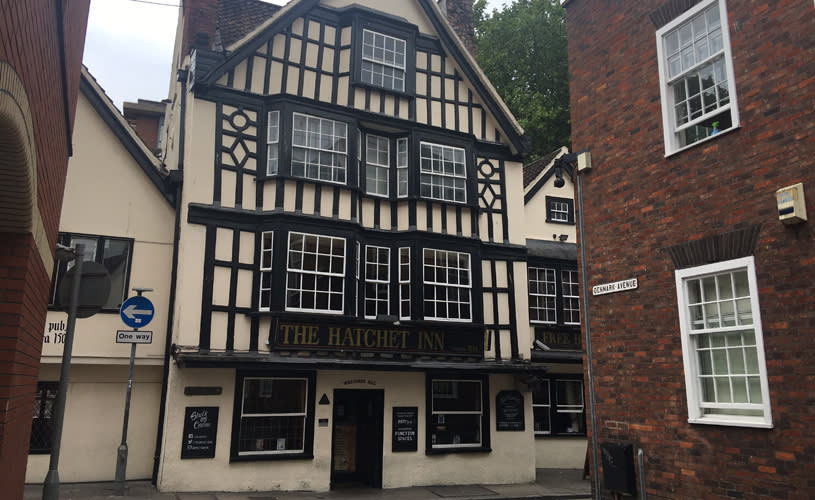
Image: The Hatchet - credit Weird Bristol
The Hatchet Inn
Bristol’s oldest pub, this atmospheric Tudor watering hole can be found on Frogmore Street, opposite Bristol's O2 Academy… with pints being pulled here from before the time of The Glorious Revolution! Dating back to 1606 and its name inspired by the woodsmen from the nearby Clifton Wood, one of the most grisly stories associated with The Hatchet Inn focuses on the door itself – apparently covered in human skin! It is said that under the black paint, the door is layered with tanned skin, reputed to be that of a hanged convict. No wonder it is said to be haunted!
The pub has also seen various dark and gritty uses over the years, including tales of former cock fighting and bare-knuckle boxing, whilst there was also thought to be a rat pit behind the venue by the 18th century. There are dark tales of the clientele as well as conditions, as the notorious pirate Blackbeard was reported to be a regular.
Luckily, today, the visitors are much less frightening and The Hatchet Inn (now a Butcombe Brewery pub) has a strong reputation for putting on quality rock and metal live music upstairs, whilst serving a great selection of drinks (with the recent addition of a vegan pop-up kitchen Soy Ahoy within) too.
- Hear more about Bristol's historic pubs with the Weird Bristol Pub Crawl
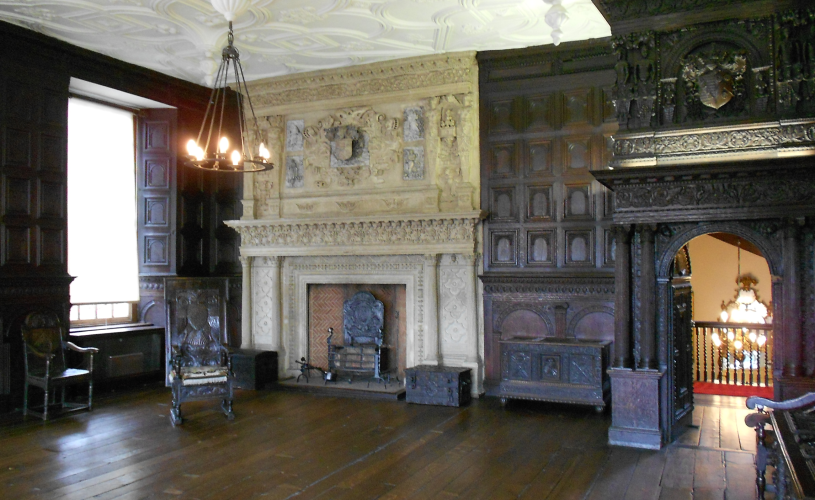
Image: The Red Lodge - credit Visit Bristol
The Red Lodge
The Red Lodge is an enigmatic Elizabethan townhouse. Behind its iconic bright red door lies over 400 years of history, which is ready to explore. Tucked away close to the Christmas Steps – the route originally leading to the former city gallows on St Michael's Hill – The Red Lodge was originally designed as a building for the former Great House, a place that Queen Elizabeth I apparently stayed in during a visit. Now it is a fascinating museum and the rooms within tell the history of the house at different periods.
There is the Tudor Great Oak Room and Small Oak Room, whilst Georgian Rooms include the Print Room and parlour. The Red Lodge even served for a time as a Victorian Girls Reform school, run by the social reformer Mary Carpenter (1807 –1877), who is herself buried in Arnos Vale Cemetery. Now, there is an exhibition room within the lodge containing a small display that documents this time.
The Red Loge boasts other hidden delights too. The first is its walled garden, thought to be a prime example of an Elizabethan knot garden complete with herbaceous borders, containing plants that all could have been found in England as early as the 17th century. Another fascinating feature is a stone well within a downstairs room, thought to have been dug when the lodge itself was built in 1580. Free to visit, The Red Lodge Museum is open to the public Monday, Tuesday, Saturday and Sunday from 11am to 4pm.
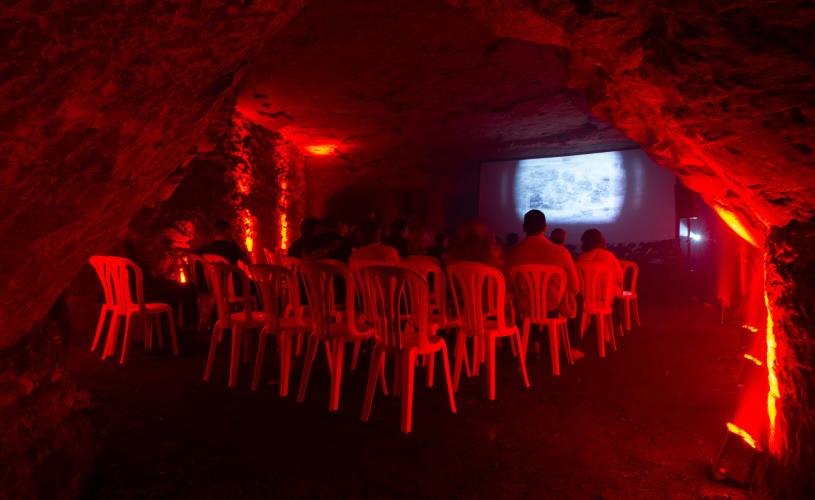
Image: Redcliffe Caves - credit Bristol Film Festival
Redcliffe Caves
Take a trip down to the Redcliffe area of the city and in the cliff face there can be found The Redcliffe Caves: three unusual openings burrowing deep into the red sandstone that inspire the name of the area. Although a metal gate fronts each entrance, these are occasionally open for immersive events and tours, with more details available on the website here.
Don’t be fooled by the name though, as these ‘caves’ are actually manmade. They were originally dug as mine tunnels, with the first digging efforts thought to have started as early as the Middle Ages, with the majority taking place between the 17th and 19th centuries. This extensive digging into the cliffs over time, extracting material (sand in particular) for use in the pottery and glass industries, means that the tunnels spread a long way… with the full extent still not fully known!
The currently mapped area of ‘The Redcliffe Caves’ impressively extends nearly as far as Bathurst Basin and it is fascinating to think that passageways could bury well into the city. Damage to some of the tunnel system from a WWII bomb has also meant that the full range of the system may never be fully known, and the mysterious depth of the tunnels has led to plenty of strange stories. One is the rumour that the caves once linked with tombs at St Mary Redcliffe church, another is that slaves were held here. There is currently little evidence to support this latter claim, though other stories – including that prisoners from the French Revolutionary and Napoleonic Wars were held in the caves – are perhaps more likely.
- See more mysterious locations on the Dark Bristol Walking Tour
Other unusual tales associated with the tunnels include that they have served as a home for hermits (including a character called John Sparkes in the 14th century), used for goods storage (with unusual items reported in 19th century newspapers including elephant tusks and palm oil) and even surveyed for use as an air raid shelter. No wonder this varied human use of the tunnel system over time has led to various tales of ghosts and spirits wandering the passages.
There are also fascinating features within, including straw stalactites, a carving of a ‘little man’ in the cave wall, a 6m deep well shaft, and wall arches of stone, brick and even concrete that have been added to strengthen the structure. More recently, the caves have come alive as an exciting venue for theatre productions and even as a Bristol Film Festival venue.
You might also like
Pin it for later;






